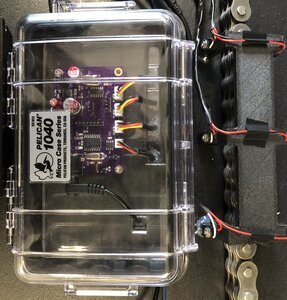
College of Engineering Unit:
The goal of this project is to create a chain elongation monitor for the Hyster-Yale Group that will automatically detect a worn lift chain and notify an operator to replace said chain. Chains, especially lifting chains, need to be frequently inspected to ensure they meet specifications. A 3% increase in a chain’s length can reduce its lifting capacity by 15%. This can become a dangerous hazard if out-of-spec chains are not caught.
Currently, this inspection is either done by hand or by expensive third party devices, thus the creation of a cheap electronic alternative is very desirable. We plan to use three pairs of IR LEDs and IR receivers that will act as our sensors. These pairs will be situated in such a way that the IR “beam” will break when a chain link passes the sensor and reconnect in the gap between chain links. One pair will be used to measure the speed, while the other two will measure the “stretch” of the chain by recording the time difference between activations and calculating a length measurement.
In addition to the sensors, the device will consist of a power circuit to convert a Forklift’s 24V power into 5Vs, a CAN communication circuit, and a microcontroller to calculate the elongation based on the sensors and send those measurements via the CAN Circuit to the Hyster Vehicle. We chose an ATTiny814 for our microcontroller as it is a relatively small and cheap microcontroller and is capable of performing necessary functions, such as basic calculations and time measurement.
Our project partner has specified that the device needs to meet four requirements:
-
The device needs to measure chain “stretch” (wear) within ±5% of the actual measurement.
-
The device, specifically the electronics, need to cost less than $15 or less at a production quantity of 15,000/yr
-
The device need to be robust enough to survive abrasive (high chain wear) applications
-
The device needs to communicate using the CAN communication protocol
At the end of our project, we were able to meet 3 of the 4 project partner requirements with the accuracy requirement being the one that was not met. This is mostly due to not having enough time to finish experimenting and debugging the code. With better time management and planning, we would have been able to finish the development of our code and could have met the final requirement.
Project Website(s):
Industry Sponsor(s):
| Attachment | Size |
|---|---|
| 10.93 MB | |
| 2.02 MB |